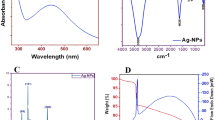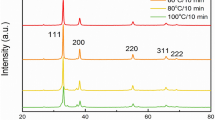Abstract
In this study, the conditions and mechanism of antibacterial activity of hydrophilic polymer coated silver nanoparticles (AgNPs) against E. coli O157:H7 (CMCC44828) as model pathogen was studied. The AgNPs were coated with amphiphilic polymer that introduced carboxyl groups on the surface to make it water-soluble. The AgNPs were exposed to various treatment conditions of pH and temperature before these were combined with the E. coli. The mechanism of the antibacterial activity was studied through the formation of reactive oxygen species (ROS) that was later suppressed with antioxidant to establish correlation with the AgNPs antimicrobial activity. Studies were carried out at both anaerobic and aerobic conditions. The results indicated that 5 mg/L AgNPs inhibited ~50% of the growth of 106 colony forming units per milliliter (cfu/mL) E. coli cells in liquid Luria–Bertani (LB) medium. This dose-dependent antimicrobial activity was higher at increased temperature (37°C) but was lower when the AgNPs were treated with acid at pH 2 before exposure to the bacteria. It was also established that the conditions of higher antimicrobial effect generated more ROS that was dependent on the presence of oxygen. The antibacterial activity was suppressed in the presence of an antioxidant.

Similar content being viewed by others
References
Bryan L (1988) General mechanisms of resistance to antibiotics. J Antimicrob Chemother 22:1
Cho K, Park J, Osaka T, Park S (2005) The study of antimicrobial activity and preservative effects of nanosilver ingredient. Electrochim Acta 51(5):956–960
Dibrov P, Dzioba J, Koosheh K, Gosink K, Hse C (2002) Chemiosmotic mechanism of antimicrobial activity of Ag+ in Vibrio cholerae. Antimicrob Agents Chemother 46(8):2668–2670
Dror-Ehre A, Mamane H, Belenkova T, Markovich G, Adin A (2009) Silver nanoparticle-E. coli colloidal interaction in water and effect on E. coli survival. J Colloid Interf Sci 339(2):521–526
Gong P, Li H, He X, Wang K, Hu J, Tan W, Zhang S, Yang X (2007) Preparation and antibacterial activity of Fe3O4@ Ag nanoparticles. Nanotechnology 18:285604
Gurr J, Wang A, Chen C, Jan K (2005) Ultrafine titanium dioxide particles in the absence of photoactivation can induce oxidative damage to human bronchial epithelial cells. Toxicology 213(1–2):66–73
Hamouda T, Myc A, Donovan B, Shih A, Reuter J, Baker J (2001) A novel surfactant nanoemulsion with a unique non-irritant topical antimicrobial activity against bacteria, enveloped viruses and fungi. Microbiol Res 156(1):1–7
Jain P, Pradeep T (2005) Potential of silver nanoparticle-coated polyurethane foam as an antibacterial water filter. Biotechnol Bioeng 90(1):59–63
Jones S, Bowler P, Walker M, Parsons D (2004) Controlling wound bioburden with a novel silver©\containing Hydrofiber® dressing. Wound Repair Regene 12(3):288–294
Kim K, Sung W, Suh B, Moon S, Choi J, Kim J, Lee D (2009) Antifungal activity and mode of action of silver nano-particles on Candida albicans. Biometals 22(2):235–242
Kumar V, Nagaraja B, Shashikala V, Padmasri A, Madhavendra S, Raju B, Rao K (2004) Highly efficient Ag/C catalyst prepared by electro-chemical deposition method in controlling microorganisms in water. J Mol Catal A: Chem 223(1–2):313–319
Li W, Xie X, Shi Q, Zeng H, OU-Yang Y, Chen Y (2010) Antibacterial activity and mechanism of silver nanoparticles on Escherichia coli. Appl Microb Biotechnol 85(4):1115–1122
Limbach L, Wick P, Manser P, Grass R, Bruinink A, Stark W (2007) Exposure of engineered nanoparticles to human lung epithelial cells: influence of chemical composition and catalytic activity on oxidative stress. Environ Sci Technol 41(11):4158–4163
Lok C, Ho C, Chen R, He Q, Yu W, Sun H, Tam P, Chiu J, Che C (2006) Proteomic analysis of the mode of antibacterial action of silver nanoparticles. J Proteome Res 5(4):916–924
Lovric J, Cho S, Winnik F, Maysinger D (2005) Unmodified cadmium telluride quantum dots induce reactive oxygen species formation leading to multiple organelle damage and cell death. Chem Biol 12(11):1227–1234
Mats J, Scnchez-Jimnez F (2000) Role of reactive oxygen species in apoptosis: implications for cancer therapy. Int J Biochem Cell Biol 32(2):157–170
Matsumura Y, Yoshikata K, Kunisaki S, Tsuchido T (2003) Mode of bactericidal action of silver zeolite and its comparison with that of silver nitrate. Appl Environ Microbiol 69(7):4278
Messner K, Imlay J (1999) The identification of primary sites of superoxide and hydrogen peroxide formation in the aerobic respiratory chain and sulfite reductase complex of Escherichia coli. J Biol Chem 274(15):10119
Morones J, Elechiguerra J, Camacho A, Holt K, Kouri J, Ram¨ªrez J, Yacaman M (2005) The bactericidal effect of silver nanoparticles. Nanotechnology 16:2346–2353
Neal A (2008) What can be inferred from bacterium-nanoparticle interactions about the potential consequences of environmental exposure to nanoparticles? Ecotoxicology 17(5):362–371
Neu H (1992) The crisis in antibiotic resistance. Science 257(5073):1064
Olmedo D, Tasat D, Guglielmotti M, Cabrini R (2005) Effect of titanium dioxide on the oxidative metabolism of alveolar macrophages: an experimental study in rats. J Biomed Mater Res Part A 73(2):142–149
Shrivastava S, Bera T, Roy A, Singh G, Ramachandrarao P, Dash D (2007) Characterization of enhanced antibacterial effects of novel silver nanoparticles. Nanotechnology 18:225103
Sondi I, Salopek-Sondi B (2004) Silver nanoparticles as antimicrobial agent: a case study on E. coli as a model for Gram-negative bacteria. J Colloid Interf Sci 275(1):177–182
Stoimenov P, Klinger R, Marchin G, Klabunde K (2002) Metal oxide nanoparticles as bactericidal agents. Langmuir 18(17):6679–6686
Tian Y, An L, Jiang L, Duan Y, Chen J, Jiang B (2006) Catalpol protects dopaminergic neurons from LPS-induced neurotoxicity in mesencephalic neuron-glia cultures. Life Sci 80(3):193–199
Tian J, Wong K, Ho C, Lok C, Yu W, Che C, Chiu J, Tam P (2007) Topical delivery of silver nanoparticles promotes wound healing. ChemMedChem 2(1):129–136
Yamamoto M, Kashiwagi Y, Nakamoto M (2006) Size-controlled synthesis of monodispersed silver nanoparticles capped by long-chain alkyl carboxylates from silver carboxylate and tertiary amine. Langmuir 22(20):8581–8586
Zhao G, Stevens S (1998) Multiple parameters for the comprehensive evaluation of the susceptibility of Escherichia coli to the silver ion. Biometals 11(1):27–32
Acknowledgments
This study was partly supported by a grant from “Cultivating the Excellent PhD Thesis of Jiangxi Province (YBP08A03)” of the Education Department of Jiangxi Province, China. The authors would like to thank Mr. Benjamin Jones and Mr. John Dixon for the AgNPs purification.
Author information
Authors and Affiliations
Corresponding authors
Additional information
Hengyi Xu and Feng Qu contributed equally to this study.
Rights and permissions
About this article
Cite this article
Xu, H., Qu, F., Xu, H. et al. Role of reactive oxygen species in the antibacterial mechanism of silver nanoparticles on Escherichia coli O157:H7. Biometals 25, 45–53 (2012). https://doi.org/10.1007/s10534-011-9482-x
Received:
Accepted:
Published:
Issue Date:
DOI: https://doi.org/10.1007/s10534-011-9482-x




